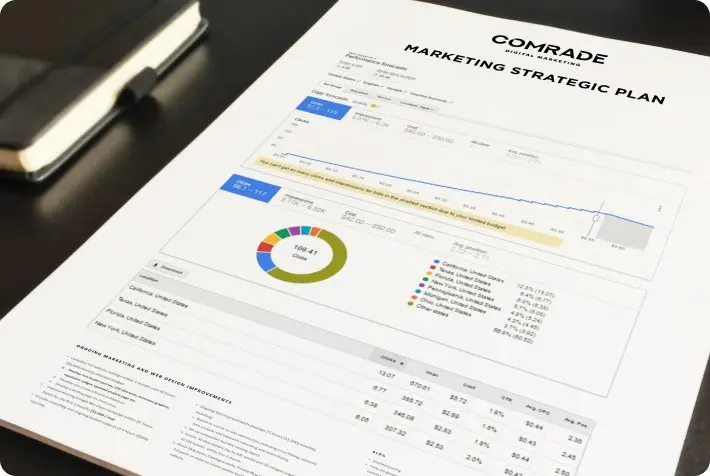For mass tort lawyers seeking new clients, effective mass tort law firm marketing has become essential. Your next big case won’t come from a billboard or referral but from search engines, where potential tort clients begin their journey. Today, 92% of people turn to Google first when looking for legal help, and 75% never scroll past the first page. That means if your firm isn’t showing up in top search results for terms like “Paraquat lawsuit lawyer” or “Camp Lejeune attorney near me,” you’re not even in the running.
Mass tort attorneys face a different SEO game than local firms. You’re not just trying to rank in your city—you’re competing against national giants with massive marketing budgets and entire teams dedicated to search engine dominance.
But here’s the opportunity: with smart, data-driven SEO tailored for mass torts, your firm can punch above its weight and consistently attract high-value leads, without draining your resources.
In this guide, we’ll walk through eight proven SEO strategies crafted specifically for mass tort lawyers ready to rise above the noise.

Mass Tort Lawyer SEO: Why Traditional Marketing Isn’t Enough
Mass tort marketing exists in its own universe.
Unlike divorce or criminal defense lawyers who primarily compete locally, mass tort attorneys often compete nationally for clients affected by dangerous drugs, defective products, and environmental disasters. This creates a hyper-competitive landscape where the stakes are enormous.
Consider these eye-opening statistics:
- Firms spend an average of $12,500-$45,000 to acquire a single mass tort client
- Nearly 66% of mass tort plaintiffs research online before deciding which firm to contact
- The typical mass tort lead converts after 7-9 digital touchpoints with a law firm
The old approach of throwing up a basic website with some keywords simply doesn’t cut it anymore.
Google’s increasingly sophisticated algorithms, including AI systems like RankBrain, now evaluate your content based on expertise, authority, and trustworthiness (E-E-A-T). For mass tort firms, this means your SEO strategy must demonstrate specialized knowledge while simultaneously connecting with potential mass tort clients on a human level.
AI search experiences like Google SGE are also rewriting the rules. Instead of clicking through blue links, potential clients now see summarized answers pulled directly from the web. If your content isn’t structured to appear in these AI summaries, you’re missing critical opportunities.
And here’s the truth most marketing agencies won’t tell you: Mass tort lawyer SEO requires a different framework than general practice law firm marketing.
Let’s dive into the strategies that work in today’s environment.
1. Craft a Comprehensive SEO Strategy for Sustainable Growth
Random SEO tactics might generate occasional traffic spikes, but they won’t deliver consistent client acquisition. Mass tort lawyers need a cohesive strategy tailored to their unique practice.
Beyond Keywords: Building Your Mass Tort SEO Foundation
Start by auditing your current digital presence. What mass torts are you actively pursuing? Which ones are most profitable? Where do you currently rank for related terms?
Next, develop a comprehensive roadmap that integrates:
- Technical SEO fundamentals: Site speed, mobile optimization, and indexability
- Content strategy: Educational resources across the client journey
- Authority building: Backlinks from legal directories and news sites
- Conversion optimization: Forms, chat, and phone tracking
A proper search engine optimization strategy for mass tort firms should be a living document, regularly updated as new litigation emerges and Google algorithms evolve.
Setting Clear, Measurable Goals
Generic web design goals like “rank higher” aren’t sufficient. Instead, establish specific KPIs:
- Increase organic traffic to Zantac litigation pages by 35% in Q3
- Generate 25 qualified Camp Lejeune leads monthly from organic search
- Improve conversion rate on CPAP mass tort landing pages from 3% to 5%
By tying your SEO efforts to business outcomes, you’ll maintain focus on activities that directly impact your firm’s bottom line.
Mass Tort Advertising: Learning from Industry Leaders
The mass tort space has clear digital leaders. Study firms like Morgan & Morgan, Sokolove Law, and other dominant players to understand their strategies, but don’t simply mimic them.
Instead, identify gaps in their approach that you can leverage. Perhaps they’re neglecting mobile optimization, using outdated content formats, or missing key informational topics that potential clients search for.
Tools like Semrush, Ahrefs, and SpyFu can reveal competitor traffic sources, keyword rankings, and content performance, giving you actionable intelligence to inform your unique approach.
2. Conduct In-Depth Keyword Research to Target the Right Audience
Effective keyword research for lawyers goes beyond basic terms like “mass tort attorney.” You need to understand the entire client journey and the specific language potential clients use at each stage.
Mapping the Mass Tort Client Journey Through Keywords
Mass tort clients typically follow a predictable search pattern:
- Awareness stage: “Roundup cancer link,” “CPAP recall information”
- Consideration stage: “Do I qualify for Zantac lawsuit,” “Camp Lejeune settlement amounts”
- Decision stage: “Best mass tort lawyer for Philips CPAP,” “experienced 3M earplug attorney”
For each active mass tort you’re pursuing, develop keyword clusters that target all three stages, prioritizing terms with both meaningful search volume and clear user intent.
Focus on High-Intent Keywords With Manageable Competition
While “mass tort lawyer” might seem attractive with its high search volume, the competition is fierce, and the intent is often unclear. Instead, target more specific terms like:
- “Paraquat lawsuit criteria”
- “How to file a Camp Lejeune claim”
- “Average AFFF firefighting foam settlement amount”
These longer, more specific phrases attract highly qualified prospects and typically face less competition from national firms.
Use AI Tools to Uncover Question-Based Keywords
Legal AI tools like ChatGPT are powerful allies for identifying question-based keywords. Try prompting: “What questions might someone have before filing a Roundup lawsuit?” to generate dozens of potential content topics that align with real client concerns.
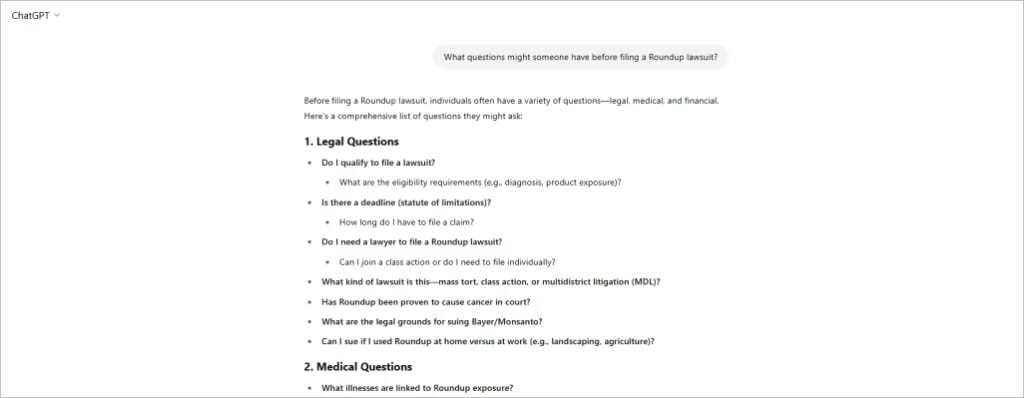
Google’s “People Also Ask” sections also provide invaluable insight into related queries that potential clients are searching for.
Remember to research your intake calls and consultation notes. The actual language clients use when describing their situations should directly inform your keyword strategy.
3. Enhance Technical SEO to Improve Site Performance and Crawlability
Even the best solo law firm websites can fall short if technical SEO issues are ignored. For mass tort lawyers competing on a national scale, a rock-solid technical foundation is non-negotiable.
Site Speed: The Silent Client Killer
When someone discovers they may have been harmed by a dangerous product, they won’t wait for a slow website to load. In fact, 53% of mobile users abandon sites that take more than 3 seconds to load.
To improve your site speed:
- Compress images without sacrificing quality
- Implement browser caching
- Minimize render-blocking resources
- Consider a content delivery network (CDN)
- Upgrade to performance-focused hosting
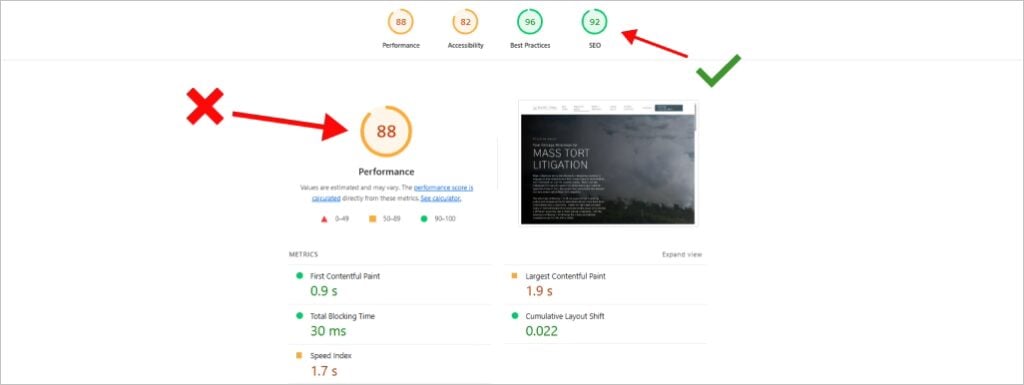
Google’s PageSpeed Insights tool can identify specific opportunities to improve your loading times.
Mobile Optimization is Non-Negotiable
Over 60% of legal searches now happen on mobile devices, so if your website isn’t optimized for smartphones and tablets, you’re missing out on potential clients. To keep things smooth, make sure your site is easy to navigate, the text is clear without zooming, and the buttons are easy to tap. Don’t forget to make your forms mobile-friendly and include a click-to-call option so clients can reach you instantly!
Schema Markup: Help Search Engines Understand Your Practice
Schema markup is like a helpful guide for search engines, making it easier for them to understand your website. For mass tort lawyers, adding the right schema can improve how your site shows up in search results.
Focus on types like LegalService, Attorney, FAQPage, ReviewSchema (to highlight those great client reviews), and LocalBusiness (for your office locations). This structured data lets Google showcase your practice with star ratings, expanded FAQs, and other features that grab potential clients’ attention.
Crawlability: Ensure Google Sees Everything
If search engines can’t properly crawl your site, even the best content won’t rank. Common crawlability issues for law firm websites include:
- Lack of XML sitemaps
- Robots.txt errors blocking important pages
- Duplicate content issues
- Poor internal linking structure
- Orphaned pages (not linked from anywhere)
Regular technical audits using tools like Screaming Frog, Semrush, or Ahrefs can identify and help resolve these issues before they impact your search engine rankings.
4. Implement Local SEO Tactics to Dominate Local Search Results
Even if your law firm handles mass tort cases across the country, investing in local SEO for lawyers is still essential for building trust and attracting clients in your community.
Google Business Profile: Your Digital Storefront
Your Google Business Profile is like your firm’s digital storefront, so it’s important to make it shine. Start by making sure your business name, address, and phone number (NAP) are up-to-date. Then, choose the right categories, like “Personal Injury Attorney,” so clients can easily find you. Add a few photos of your office and team to give your profile a personal touch.
Write a clear, keyword-rich description that explains what you do and what makes your firm stand out. Be sure to include all your mass tort practice areas in the services section. And to keep things fresh, post regular updates about ongoing cases, settlements, and helpful insights that show you’re active and ready to help clients.
Fake firms are everywhere. Learn how to spot a fake law firm on a Google Business Profile.
Mass Tort Lead Generation: Leveraging Reviews and Testimonials
Make reviews work for you! Since 84% of people trust online reviews just as much as personal recommendations, they can seriously boost your reputation. After a successful case, kindly ask for feedback, share a simple link with satisfied clients, and always respond to reviews—good or bad—with care and professionalism. And remember, showcasing glowing testimonials on your website and lawyer review sites is a powerful way to build trust and credibility with potential clients.
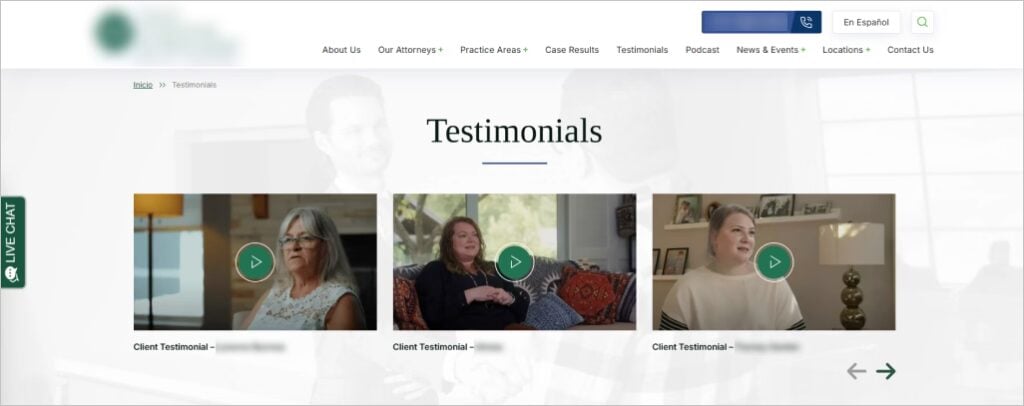
Create Location-Specific Landing Pages
If your firm has multiple offices or serves clients in various regions, create dedicated pages for each location. These pages should include:
- Location-specific content (not duplicated across pages)
- Local landmarks and geographic references
- Maps and directions to your office
- Information about local courts relevant to mass torts
- Testimonials from local clients (when available)
This approach helps you rank for location-specific searches like “Camp Lejeune lawyer in Atlanta” while also strengthening your overall domain authority.
Leverage Local Citations and Directories
Consistent citations across the web reinforce your firm’s legitimacy to both search engines and potential clients.
Submit your firm to these key platforms:
- Legal directories (Avvo, FindLaw, Justia, Martindale-Hubbell)
- Local business directories (Yelp, Yellow Pages, BBB)
- Chamber of Commerce listings
- State and local bar association directories
Ensure your NAP information is identical across all platforms to avoid confusing search engines and potential clients.
5. Optimize Your Web Design for User Experience and SEO Success
A potential client’s first impression usually comes from your law firm website. No matter how strong your SEO is, a bad design can drive them away.
Design for Trust and Conversion
Mass tort clients are often going through difficult medical and financial situations, so it’s crucial for your website to feel both trustworthy and compassionate. Make sure visitors can easily contact you through clear options like phone, chat, or forms, and provide straightforward details about your firm’s experience handling mass tort cases.
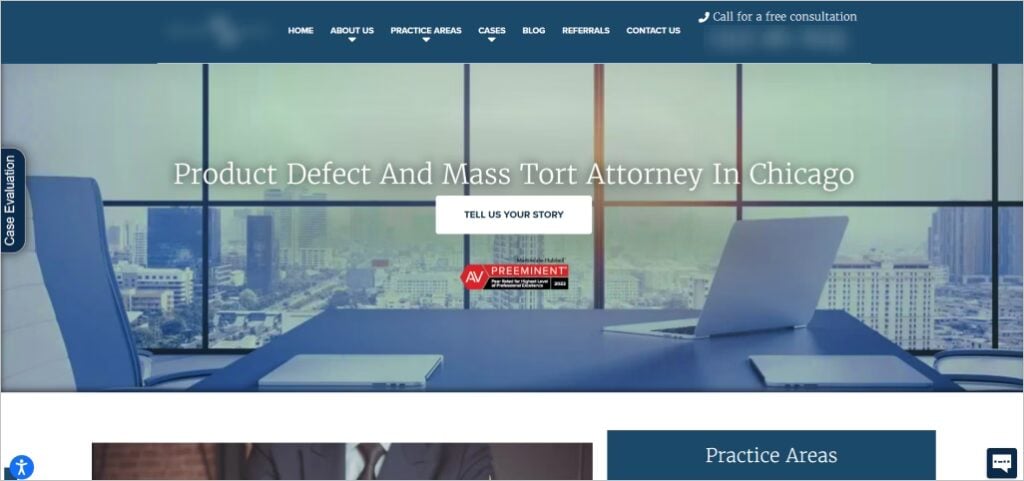
Your site should also include simple case evaluation forms, client testimonials (with proper disclaimers), and professional team photos to build confidence. Keep the design clean and free of distractions—avoid overwhelming popups or clutter—so visitors can focus on getting the help they need during a challenging time.
Site Architecture: Organize for Users and Search Engines
How you structure your site impacts both user experience and SEO performance. For mass tort firms, consider a hub-and-spoke model:
- Main practice area page for mass torts (the hub)
- Individual pages for each litigation (CPAP, Roundup, etc.)
- Supporting content clustering around each litigation
This approach creates clear topical relevance, improves internal linking opportunities, and makes it easier for potential clients to find exactly what they’re looking for.
Page Load Speed and Core Web Vitals
Google’s Core Web Vitals measure user experience factors like loading speed, interactivity, and visual stability. Poor performance on these metrics can directly impact your rankings.
Prioritize these improvements:
- Optimize largest contentful paint (LCP) by streamlining initial load
- Minimize cumulative layout shift (CLS) to prevent frustrating page jumps
- Reduce first input delay (FID) for better interactivity
Tools like Google’s PageSpeed Insights and Lighthouse can identify specific opportunities for improvement.
Mobile-First Design is Essential
Since most people are browsing on their phones, your website needs to prioritize mobile users. This means making sure navigation is smooth on smaller screens, key information is easy to find without scrolling, and buttons are simple to tap. Your site should also load quickly on mobile networks and have click-to-call features for easy contact. And here’s the kicker—Google ranks based on your mobile site first, so if it’s not optimized, you’re already behind. Mobile optimization isn’t just a nice-to-have; it’s a must to stay competitive in the fast-paced world of mass tort law.
Is Super Lawyers legit? Find out how they really choose attorneys!
6. Create High-Quality, Optimized Content That Drives Traffic
For mass tort lawyers, effective SEO still begins with strong content. But in such a competitive field, generic legal blogs won’t cut it. Strategic content marketing for lawyers is essential.
Develop Comprehensive Mass Tort Landing Pages
For every mass tort case your firm handles, it’s essential to build a dedicated landing page that acts as a comprehensive hub of information. These pages should clearly outline the risks of the product or drug, provide an up-to-date summary of the mass tort litigation, and explain who qualifies as a potential plaintiff.
Include estimated settlement amounts and timeframes when available, highlight your firm’s experience with the case, and feature an FAQ section to answer common client concerns. Regular updates and compelling calls-to-action will ensure these pages stay relevant and drive valuable case evaluations.
Create Client-Centric Blog Content
Your blogging strategy should focus on answering real questions that potential clients have about mass torts. Effective formats include:
- Litigation updates (“Latest Roundup Settlement News for May 2025”)
- Explanatory content (“How the Camp Lejeune Justice Act Affects Your Claim”)
- Process guides (“5 Steps to Take If You’ve Been Affected by Philips CPAP”)
- FAQ compilations (“Answers to Common Questions About 3M Earplug Lawsuits”)
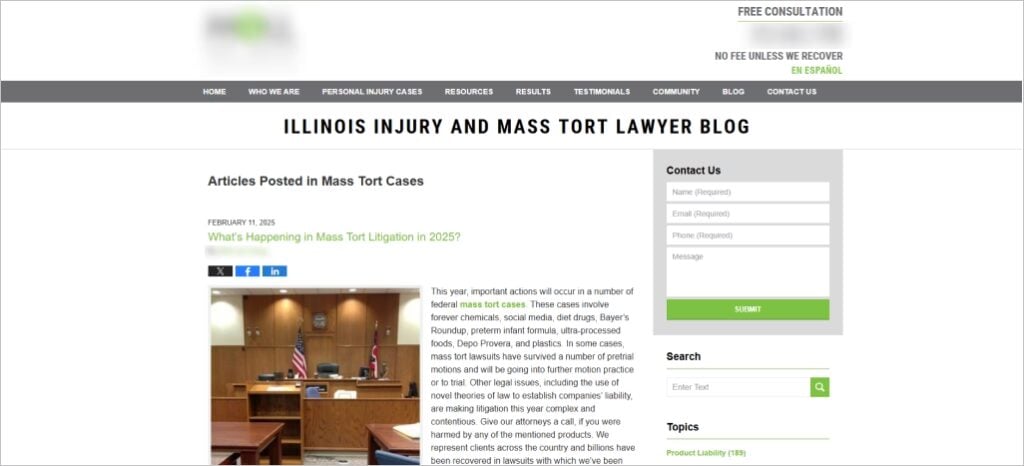
Each piece should be thoroughly researched, factually accurate, and written in accessible language that avoids unnecessary legal jargon.
Optimize for Featured Snippets and AI Summaries
With AI-generated summaries becoming more prominent in search results, structured content has never been more important.
To increase your chances of appearing in these prime positions:
- Include concise, direct answers to common questions
- Use clear headers (H2, H3, H4) to organize content logically
- Implement bulleted and numbered lists where appropriate
- Include tables for comparative information
- Add FAQ schema to relevant sections
This structure not only helps with featured snippets but also improves readability for potential clients.
Develop Supporting Resources and Tools
Set your firm apart by creating resources that truly help your clients, like eligibility checkers, settlement calculators (with proper disclaimers), and timeline visualizations to track litigation progress. These tools go beyond basic content and offer real value for those navigating complex legal situations.
Offering downloadable guides and video explanations of tough legal concepts not only educates your clients but also boosts your firm’s online presence. These resources are great for attracting backlinks and social shares, helping your firm build trust and get noticed in search results.
7. Build a Strong Backlink Profile Through Strategic Link Building
In the fast-paced world of mass tort SEO, your backlink profile plays a pivotal role in your search rankings. For effective link building for lawyers, focusing on quality rather than quantity is key.
Focus on Legal-Relevant Backlinks
For mass tort lawyers, it’s important to focus on high-quality backlinks that truly boost your SEO. Aim for authoritative sources like legal directories, professional associations, and law school publications. You can also gain valuable links from legal journals, news sites that cover litigation, and mass tort advocacy groups.
These kinds of links can help improve your rankings for competitive search terms. Even a few backlinks from these trusted sources can have a big impact. Getting links from legal tech platforms or practice management sites can further strengthen your online presence, helping your site rank higher and bringing in more relevant traffic to your practice.
Create Link-Worthy Content
The best way to build links sustainably is by creating content that people genuinely want to reference. This could be original research on mass tort trends, in-depth breakdowns of major court rulings, or comprehensive guides on specific types of litigation. Expert interviews with medical professionals or data visualizations of settlement trends also provide real value and naturally attract attention.
When you produce content like this, it doesn’t just help with SEO—it shows your expertise and establishes trust. As others see the value in your work, they’ll naturally link back, further strengthening your online presence and helping potential clients find you. This is where legal copywriting can truly make a difference in enhancing your reputation.
Guest Posting and Expert Commentary
Position your attorneys as trusted experts by strategically sharing their insights across various platforms. Writing guest posts for legal publications, offering expert commentary for news stories, and joining podcast interviews on relevant topics are great ways to get their voices heard. These efforts not only help build their reputation but also attract more attention from a wider audience.
Joining legal forums, engaging in discussions, and hosting webinars takes things even further. By sharing valuable knowledge in these spaces and providing access to recorded webinars, you’re not just boosting your attorneys’ credibility—you’re also creating high-quality backlinks. It’s a powerful way to build personal brands, earn trust, and make your firm stand out in the legal world.
Monitor and Disavow Toxic Links
Spammy or irrelevant backlinks can harm your rankings just as much as good links help them. Regularly audit your backlink profile using tools like Ahrefs, Semrush, or Moz, and disavow links that may be detrimental to your site’s authority.
Pay particular attention to:
- Links from irrelevant or low-quality websites
- Exact-match anchor text patterns that appear manipulative
- Links from sites in languages you don’t speak
- Multiple links from the same IP address
- Links from known link farms or private blog networks
Google’s disavow tool allows you to tell search engines to ignore these problematic links when evaluating your site.
8. Optimize On-Page SEO Elements for Maximum Visibility
On-page optimization ensures that your content matches the specific search terms potential clients are using. For mass tort lawyers, these technical aspects can have a significant impact on rankings for competitive keywords, making them important Google ranking factors for lawyers.
Craft Strategic Title Tags and Meta Descriptions
Title tags remain one of the most important ranking factors and directly impact click-through rates from search results.
For mass tort pages, effective titles follow this formula:
- Primary keyword + Secondary benefit + Brand name
Examples:
- “Camp Lejeune Lawyer | $800M+ Recovered for Veterans | Madison Law”
- “Roundup Cancer Lawsuit | Free Case Review | Jefferson Legal Group”
Meta descriptions may not boost your rankings, but they can help improve click-through rates. Use your main keywords, showcase what makes your offer stand out, and include a clear call-to-action. And if it fits, add a little urgency to encourage clicks right away!
Optimize Header Structure for Clarity and SEO
Headers (H1, H2, H3, etc.) provide structure for both readers and search engines. For mass tort content:
- Use a single H1 containing your primary keyword
- Structure H2s around main subtopics and secondary keywords
- Utilize H3s for detailed breakdowns within sections
- Ensure headers follow a logical hierarchy
- Include relevant keywords naturally in headers
This structure improves readability and helps search engines understand your content’s organization and focus.
Implement Strategic Internal Linking
Internal linking is a smart way to guide visitors through your website while boosting your SEO. For instance, linking general mass tort pages to specific litigation pages gives users easy access to more detailed information. You can also connect related content with natural, context-driven links and use descriptive anchor text that includes important keywords to make everything flow seamlessly.
A well-planned internal linking strategy makes your site easier to navigate for users and helps search engines understand how your content fits together. Linking from high-authority pages to newer content helps spread page authority, and adding breadcrumb navigation makes it easier to explore, especially on larger sites. This approach improves both the user experience and your site’s SEO performance.
Optimize Images for Search and Performance
Images can be a great way to boost engagement on your site—but if they’re not properly optimized, they can do more harm than good by slowing things down. To make sure your images are helping, not hurting, start by compressing them to reduce file size without sacrificing quality. Use descriptive, keyword-rich file names and add alt text that clearly explains the image while incorporating relevant keywords.
It’s also important to set image dimensions to prevent layout shifts and use lazy loading for images further down the page. When optimized correctly, images can even show up in Google Image search, driving additional traffic to your site. With just a few simple tweaks, you’ll not only enhance your site’s speed and performance but also increase its visibility and potential for growth.
Measuring Success: Turn Data Into Actionable Insights
Effective SEO isn’t set-and-forget – it requires ongoing measurement and refinement. For mass tort lawyers, these metrics matter most:
Track the Right KPIs
To truly measure your business’s digital success, it’s important to focus on KPIs that drive real results, not just vanity metrics. Key indicators to watch include organic traffic to your mass tort landing pages, conversion rates for case evaluation forms, and call tracking from organic search visitors.
You should also keep an eye on changes in rankings for high-priority keywords, growth in domain and page authority, and how often you show up in local search results.
Staying on top of these metrics requires consistent tracking, so setting up regular reports—ideally monthly—is crucial. This allows you to spot trends, evaluate how things are going, and make adjustments to your strategy, ensuring everything stays on track with your overall business goals.
Attribution Modeling
Understanding which touchpoints influence potential clients helps optimize your marketing mix:
- First-click attribution identifies which channels initially bring visitors
- Last-click shows which platforms drive final conversions
- Multi-touch models reveal the complete client journey
This insight allows you to allocate resources to the channels and tactics generating the highest ROI.
Continuous Optimization
To improve your SEO, it’s essential to regularly review performance data and make adjustments. A/B testing different elements on your landing pages can help boost conversion rates, while adding more content around popular topics keeps your site relevant. Don’t forget to address pages with high bounce rates or low engagement – improving these can keep visitors around longer and reduce drop-offs.
Focusing on keywords that are gaining traction is also crucial, as is tweaking meta descriptions for pages that aren’t performing as well. This continuous, data-driven approach helps your SEO strategy stay flexible and responsive to changes in algorithms and customer behavior, ensuring your site remains competitive and engaging.
Conclusion: The Path Forward for Mass Tort Lawyers
The digital marketing for tort lawyers has become increasingly complex and competitive. Successful mass tort law firm marketing requires a sophisticated approach. Generic SEO approaches simply won’t generate the results you need to compete nationally for high-value cases.
By implementing the eight strategies outlined in this guide, your firm can build a sustainable competitive advantage that continuously attracts qualified leads for current and future mass torts.
Remember that effective SEO isn’t about quick fixes or shortcuts – it’s about creating a digital ecosystem that demonstrates your expertise, builds trust with potential clients, and consistently positions your firm ahead of competitors when it matters most.
The most successful mass tort firms approach SEO as a long-term investment, not a short-term expense. With the right strategy and consistent execution, your firm can dominate the digital landscape and secure a steady stream of valuable cases for years to come.
Ready to transform your mass tort firm’s digital presence? Schedule a free consultation with our legal SEO specialists today.
Frequently Asked Questions
-
How long does it take to see results from SEO?
The timeline to see results from an SEO campaign can vary, but typically it takes a few months to start noticing improvements. In the case of mass tort SEO campaigns, it can take time to generate mass tort leads due to the competitive nature of the mass tort world and multiple law firms targeting similar keywords. Regular monitoring via Google Analytics will help you track progress.
-
Should you hire an SEO professional or agency for your mass tort law firm?
Hiring an SEO agency specializing in mass tort marketing strategies can be a great choice for generating new mass tort clients. SEO professionals will help you craft successful SEO strategies tailored to mass tort services and ensure you stay ahead of competing law firms. Mass tort marketing campaigns need expert handling to navigate the complexities of digital marketing in the legal industry.
-
What should you look for in an SEO agency for mass tort lawyers?
When choosing an SEO agency for mass tort lawyers, look for expertise in running SEO marketing campaigns that boost search visibility and effectively reach your target audience. They should focus on optimizing your site with the right target keywords to increase organic traffic and ensure a logical site structure for a better user experience and indexing. The agency should understand the unique needs of most mass tort lawyers and tailor strategies that align with those objectives.
